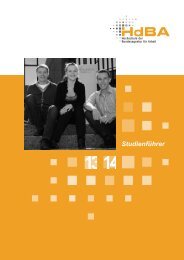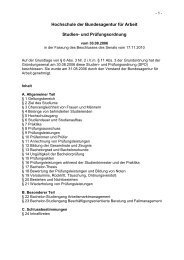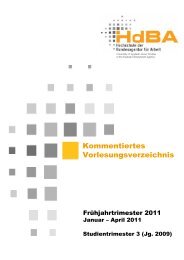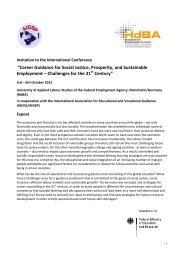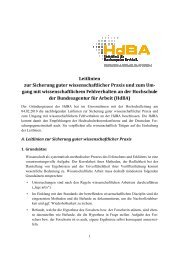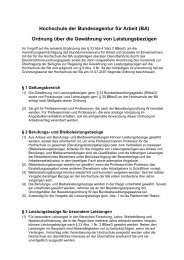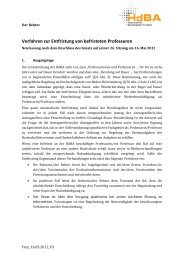Brain Drain - Hochschule der Bundesagentur für Arbeit
Brain Drain - Hochschule der Bundesagentur für Arbeit
Brain Drain - Hochschule der Bundesagentur für Arbeit
Create successful ePaper yourself
Turn your PDF publications into a flip-book with our unique Google optimized e-Paper software.
�����������������������������������������<br />
���������������������������������������<br />
�<br />
�<br />
Including all the described skills and knowledge pools the method Case Management<br />
is introduced to the participants as an efficient and effective tool to deal with specific<br />
issues of ‘<strong>Brain</strong> <strong>Drain</strong> – <strong>Brain</strong> Gain’. Here the Case Manager doesn’t appear as a<br />
counsellor in the direct sense but as a pilot and networker in a broa<strong>der</strong> sense. He<br />
navigates the supporting process by finding contact points and other experts for his<br />
client and coordinates the communication. Related to Unit 3 the special phases of<br />
Case Management are shown to the participants: assessment, planning, intervention,<br />
monitoring, and evaluation are building structural cornerstones on which the<br />
assistance process is aligned.<br />
2.6 Methodology - Proposals<br />
• Lectures and exercises<br />
• Group work<br />
• Presentation and discussion<br />
• Interviews<br />
• Role-plays<br />
•<br />
Exercise 1: Creating an interview guide for an intercultural counselling<br />
Based on the theoretical inputs of unit 3 and 4 the participants create an own<br />
interview guide for an intercultural counselling consi<strong>der</strong>ing following questions:<br />
How can the interview be structured?<br />
Which reasonable schedule lines are to be drawn?<br />
How much time is spent on each part?<br />
Exercise 2: Role-Play<br />
The discussed inputs and especially the interview guide shall be transferred into a<br />
role-play. One participant slips into the counsellor’s role another into the client’s<br />
imitating a real life counselling situation. The rest of the group observes the<br />
“counsellor’s” action so that he can receive a profound feedback later. Additionally<br />
the scene is put on camera. Every participant has to play the counsellor one time and<br />
after every round there is a feedback. The taped interview scene is given to the<br />
consi<strong>der</strong>ed participant for a self evaluation.<br />
75




